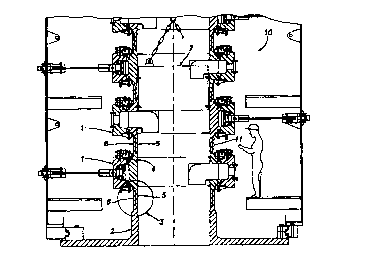Some of the information on this Web page has been provided by external sources. The Government of Canada is not responsible for the accuracy, reliability or currency of the information supplied by external sources. Users wishing to rely upon this information should consult directly with the source of the information. Content provided by external sources is not subject to official languages, privacy and accessibility requirements.
Any discrepancies in the text and image of the Claims and Abstract are due to differing posting times. Text of the Claims and Abstract are posted:
| (12) Patent Application: | (11) CA 2333612 |
|---|---|
| (54) English Title: | STRUCTURAL CONNECTION BETWEEN SWIVELS IN SWIBEL STACK |
| (54) French Title: | RACCORD STRUCTUREL ENTRE LES TETES D'INJECTION FAISANT PARTIE D'UNE PILE DE TETES D'INJECTION |
| Status: | Deemed Abandoned and Beyond the Period of Reinstatement - Pending Response to Notice of Disregarded Communication |
| (51) International Patent Classification (IPC): |
|
|---|---|
| (72) Inventors : |
|
| (73) Owners : |
|
| (71) Applicants : |
|
| (74) Agent: | FINLAYSON & SINGLEHURST |
| (74) Associate agent: | |
| (45) Issued: | |
| (86) PCT Filing Date: | 1999-06-23 |
| (87) Open to Public Inspection: | 1999-12-29 |
| Examination requested: | 2000-11-28 |
| Availability of licence: | N/A |
| Dedicated to the Public: | N/A |
| (25) Language of filing: | English |
| Patent Cooperation Treaty (PCT): | Yes |
|---|---|
| (86) PCT Filing Number: | PCT/US1999/014218 |
| (87) International Publication Number: | WO 1999067563 |
| (85) National Entry: | 2000-11-28 |
| (30) Application Priority Data: | ||||||
|---|---|---|---|---|---|---|
|
A structural connection (3) between cylindrical housings of a swivel stack
(10) is disclosed. A connector female half (6) is welded or machined to one
end of a cylindrical housing of a product swivel (1). A pin male half (5) is
welded or machined to an end of another product swivel (1) or a base member
(2). An installation tool (7) pulls the pin (5) and box (6) together, radially
expands the box (6), and then shrinks the box (6) onto the pin (5) so that non-
helical engaging threads (20) wedge together to produce axial tension in the
connection (3). The connection (3) is structurally strong enough to act as a
structural connection (3) between product swivels (1).
L'invention concerne un raccord structurel (3) entre les boîtiers cylindriques d'une pile de têtes d'injection (10). Une moitié de raccord femelle (6) est soudée ou usinée à l'une des extrémités du boîtier cylindrique d'une tête d'injection (1), l'autre moitié de raccord mâle (5) étant soudée ou usinée à une extrémité du boîtier cylindrique d'une autre tête d'injection (1) ou à un élément de base (2). Un outil d'installation (7) tire l'une vers l'autre les moitiés mâle (5) et femelle (6) du raccord, élargit radialement la moitié femelle (6) puis la resserre autour de la moitié mâle (5) de manière à mettre en prise les filets non hélicoïdaux (20) afin de créer une tension axiale dans le raccord (3). Le raccord (3) possède une résistance structurelle suffisante pour servir de raccord structurel (3) entre les têtes d'injection (1).
Note: Claims are shown in the official language in which they were submitted.
Note: Descriptions are shown in the official language in which they were submitted.

2024-08-01:As part of the Next Generation Patents (NGP) transition, the Canadian Patents Database (CPD) now contains a more detailed Event History, which replicates the Event Log of our new back-office solution.
Please note that "Inactive:" events refers to events no longer in use in our new back-office solution.
For a clearer understanding of the status of the application/patent presented on this page, the site Disclaimer , as well as the definitions for Patent , Event History , Maintenance Fee and Payment History should be consulted.
| Description | Date |
|---|---|
| Inactive: IPC from MCD | 2006-03-12 |
| Application Not Reinstated by Deadline | 2003-06-23 |
| Time Limit for Reversal Expired | 2003-06-23 |
| Deemed Abandoned - Failure to Respond to Maintenance Fee Notice | 2002-06-25 |
| Inactive: Cover page published | 2001-03-21 |
| Inactive: First IPC assigned | 2001-03-14 |
| Letter Sent | 2001-03-05 |
| Inactive: Acknowledgment of national entry - RFE | 2001-03-05 |
| Application Received - PCT | 2001-03-02 |
| Request for Examination Requirements Determined Compliant | 2000-11-28 |
| All Requirements for Examination Determined Compliant | 2000-11-28 |
| Application Published (Open to Public Inspection) | 1999-12-29 |
| Abandonment Date | Reason | Reinstatement Date |
|---|---|---|
| 2002-06-25 |
The last payment was received on 2001-06-04
Note : If the full payment has not been received on or before the date indicated, a further fee may be required which may be one of the following
Please refer to the CIPO Patent Fees web page to see all current fee amounts.
| Fee Type | Anniversary Year | Due Date | Paid Date |
|---|---|---|---|
| Request for examination - standard | 2000-11-28 | ||
| Registration of a document | 2000-11-28 | ||
| Basic national fee - standard | 2000-11-28 | ||
| MF (application, 2nd anniv.) - standard | 02 | 2001-06-26 | 2001-06-04 |
Note: Records showing the ownership history in alphabetical order.
| Current Owners on Record |
|---|
| FMC CORPORATION |
| Past Owners on Record |
|---|
| MALCOLM E. TURNER |
| MALCOLM J. PERSCHKE |